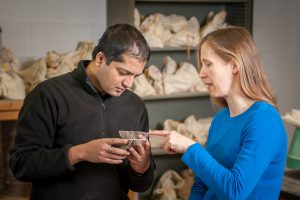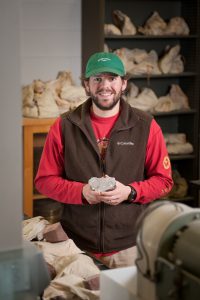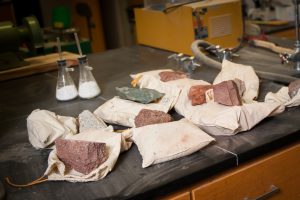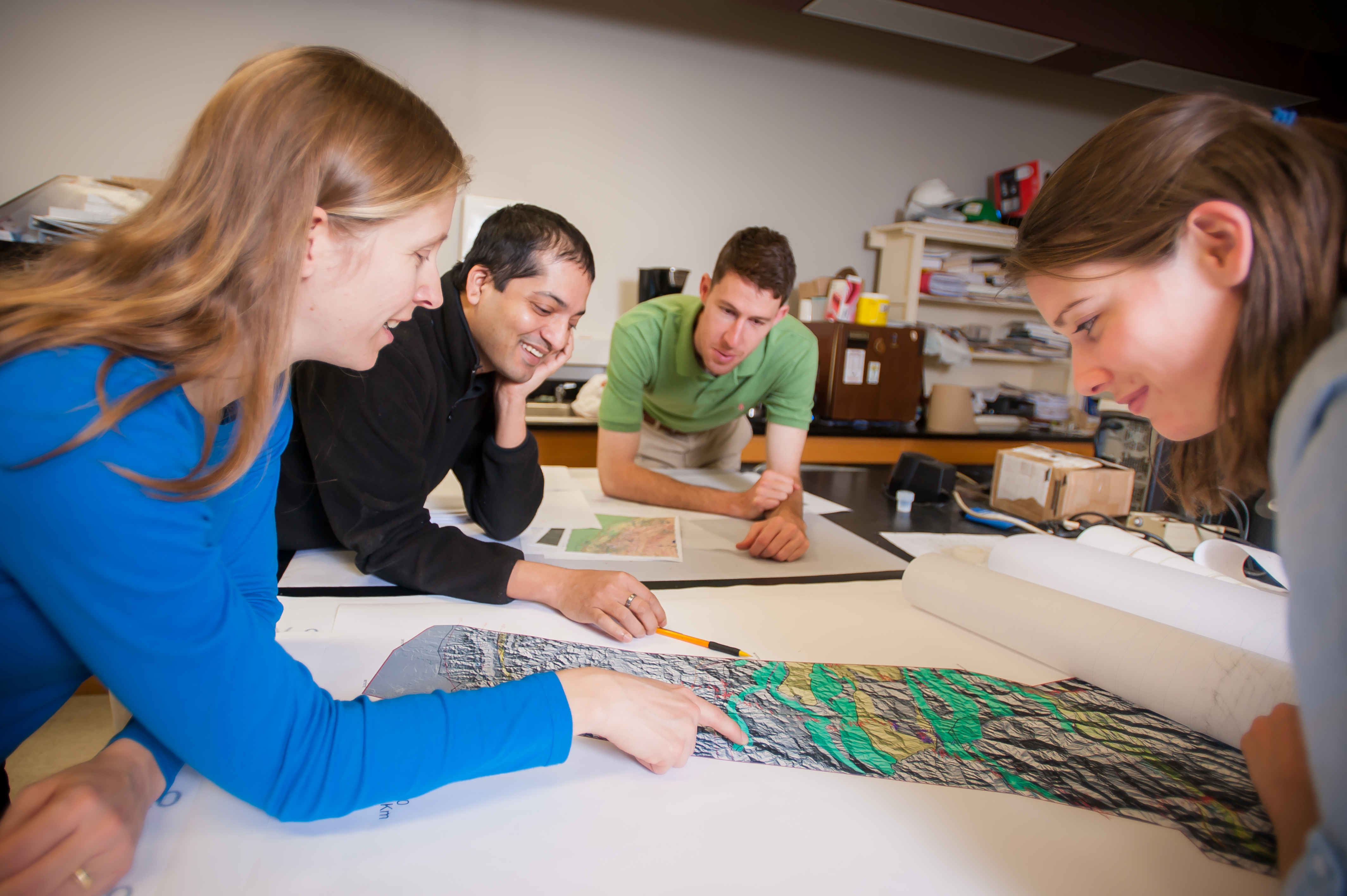By Chris Bryant
Photos by Bryan Hester

When you hold a polished zircon, you’re likely considering a December birthstone. When Dr. Delores Robinson grasps one in its natural form, she’s likely considering the early history of the Himalayan Mountain range.
Zircons are minerals. In the hands of gemologists, they can sparkle as costume jewelry. Within Robinson’s lab, zircons, and other minerals removed from rocks half a world away, are poised to reveal clues about the early formation of part of that world – the massive Asian mountain range lying between India and Tibet whose name means “the abode of snow.”
“Zircons are strong minerals that survive multiple melting and erosion events and record growth over a very long history and survive,” says Robinson, a University of Alabama geologist. “This particular mineral, we can do the chemistry on it, and that tells us how old these rocks are, but you need a lot of rock to be able to do that.”
And it’s that pursuit of “a lot of rock” – from areas on and around the world’s highest mountain peaks – that fills Robinson’s thoughts and tests her ingenuity.
Along the way, she’s overcome an earthquake, language barriers, a lack of roads and shelter and an American gut unaccustomed to dealing with the microbes found in the local water supplies, which remain untreated. She handles these issues while interacting with a native people sometimes overly fascinated with Westerners (many have seen only one, the unusual American woman scientist they have nicknamed D) and while facing the realization that if she becomes seriously injured or ill, the nearest hospital is four to five days away.
Her stories, drawn from the more than a dozen trips she’s made to the region, remind one of episodes from “The Amazing Race,” the reality TV contest depicting teams rushing across the world, dealing with obstacles while competing for a cash prize.
“I think I would probably win that game,” Robinson says with a smile. “Things happen out there that you don’t anticipate. You have to have plans A, B, C and D ready to go. There are always problems, but the challenge in working in these locations is to figure out your way around those problems.
“You have this proposal, and you need to fill the mandate or complete a dissertation (graduate students frequently accompany her), and you need to answer these questions. It doesn’t really matter how you do it, you just need to get the work done.”
Robinson’s latest challenge may be one too tough to work through, but not too tough for her to work around.

For this project, she’s particularly interested in rocks from portions of the Mesozoic Era, a period between 65.5 million and 251 million years ago. It was during this era, Robinson hypothesizes, that the Himalayans got their initial start.
Long before India and Asia crashed into one another some 55 million years ago, giving us, scientists say, Mount Everest and the modern Himalayans that today take away our collective breaths, there was something else already in the works, Robinson says.
“Tibet sits up really high, elevation-wise, about five kilometers, average elevation. Our interest is in the early history of it gaining that elevation,” Robinson says.
“Some researchers, me included, think there is an early time period … that before India and Asia collided there is a history that we have to understand before we can understand the modern rendition. I am interested in kind of taking that apart and making it India and Asia again, without the collision, and then kind of fast-forwarding it, and building a computer model of how that worked.
“To find that older history, we have to go to rocks that are of that age and study those rocks.”
And the ideal place to study rocks of that age is the province of Qamdo, in eastern Tibet. For two years; however, Westerners have been barred from the region. Monks in that area have periodically set themselves afire in protest of Chinese rule. There are concerns in the region, Robinson says, that outsiders have intentions of injecting themselves into the dispute or further publicizing it. This is not her focus, she says.
“I’m just interested in the rocks. It’s unfortunate that the best outcrop of rocks is in this particular location.”
A bordering province, Sichuan, is a second choice for further study and an area where Robinson and graduate student William Jackson visited in the spring.

The UA pair brought back to campus various additional rock samples containing not only zircons but some 500 other minerals they will analyze both in on-campus laboratories and in an Arizona lab with specialized equipment. Robinson’s National Science Foundation grants pay for her graduate students to travel both to the Far East and, upon return, to Arizona where they are receiving training on how to conduct the lab analyses.
Sometimes, Robinson says, it’s impossible to determine the ages of the collected rock samples, but through other analyses, the scientists can determine where the rocks originated – what they refer to as the rocks’s original source group – such as volcanic rock, an interior part of the continent or the mid-ocean ridge.
Knowing rocks presently in different regions originated from the same region are pieces in the mountain-building puzzle, Robinson says. Using visual analysis from microscope inspections, the researchers can determine the ratio of the hundreds of minerals found in the samples, providing additional clues as to what larger rock formation they were once a part of.
“If you knew a rock came from this particular area, well, this rock can’t come from that rock unless that rock is brought to the surface. What you have to do is bring that rock (in the computer simulation) to the surface somehow.
“It has to be done along fault lines. So, if this rock is brought to the surface, it can take that material and dump it in this other basin and that will eventually become a rock. So, if you can trace that back, then you can tell what time those rocks came to the surface, and that tells you what time those faults are moving. Hopefully, you know where the rock came from and you know it came to the surface along a particular fault, but you don’t know when it came to the surface.”

Sometimes, Robinson says, the time a fault moved toward the surface can be indirectly dated though the analysis of other minerals, including garnet.
The goal for Robinson and her students is to use data drawn from their field analyses to develop a 3-D computer model showing how the range formed in its early history.
“If you want to tell a story like this, you have to pull on as many lines of evidence as you possibly can,” Robinson says. “You collect a bunch of samples in hopes it will tell the story you think it is going to tell. If it doesn’t, why doesn’t it? And what else could you collect to try and tell the story differently.”
Closer to home, the project is also expected to grant insight into how the Appalachian Mountains formed in North America.
“When Africa and Europe and America were all together, the Appalachians were as tall as the Himalaya and Tibetan Plateau,” Robinson says. “Then, it ripped apart. What we see today is just the internal part, and all that other stuff has eroded away. We don’t know how the Appalachians were built, so if we can study a modern collision system – a continent-continent collision system – this gives us a good idea of how the Appalachians, which were also a continent-continent collision system – evolved.
“We just draw parallels between something that is happening in the modern time and try to go deeper and deeper and deeper in the past to understand the evolution of continents on the Earth.”
In the Himalaya, it’s not uncommon for Robinson to hike for three weeks straight, carrying, much of the time, everything she has brought to the region in a backpack.
“I want to know everything that is happening all the way from the high mountains down to the flat Indian plains. That requires that I traverse that multiple times so I can get a good idea about how that is constructed. ”

Though the area is quite populated, there are no roads in much of the region.
“People have made these trails to go from village to village to village.”
Native trail crews have hewn out the trails from the rocks.
“They keep these trails very nice. So, if I find a good trail, then I know I’m going to find good rocks.”
Once she spots an interesting and potentially useful sample, Robinson swings a rock hammer, breaking off a portion of the rock and placing it in her backpack.
The native people she encounters during her expeditions are, at least initially, highly curious both about Robinson’s project and her, personally.
“They can sit and watch you for a very long time and not be bored.
“They want to touch you to see what your skin is like. I’m a scientist, and we’re not usually social creatures, and it’s hard to be touched. After a while, they just realize, I’m a normal human being. And they lose interest.”
And their interest in her work?
“They want to know if there is gold in the rock. They want to know what you’re doing. They want to know why you’re doing it and if it’s advantageous for the village.
“They are really disappointed when I tell them I’m just interested in how the mountains came up. They are not really happy with that answer.”
Dr. Robinson is an associate professor of geological sciences within UA’s College of Arts and Sciences. This aspect of her research is funded by an approximate $220,000 grant from the National Science Foundation.
